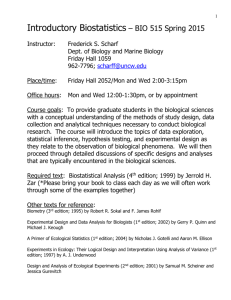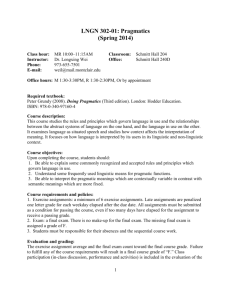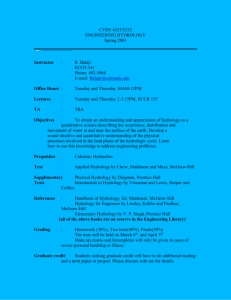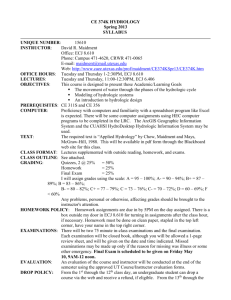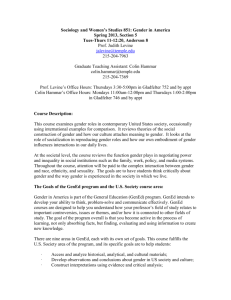MKR 5624: Introduction for Managerial Statistics
advertisement
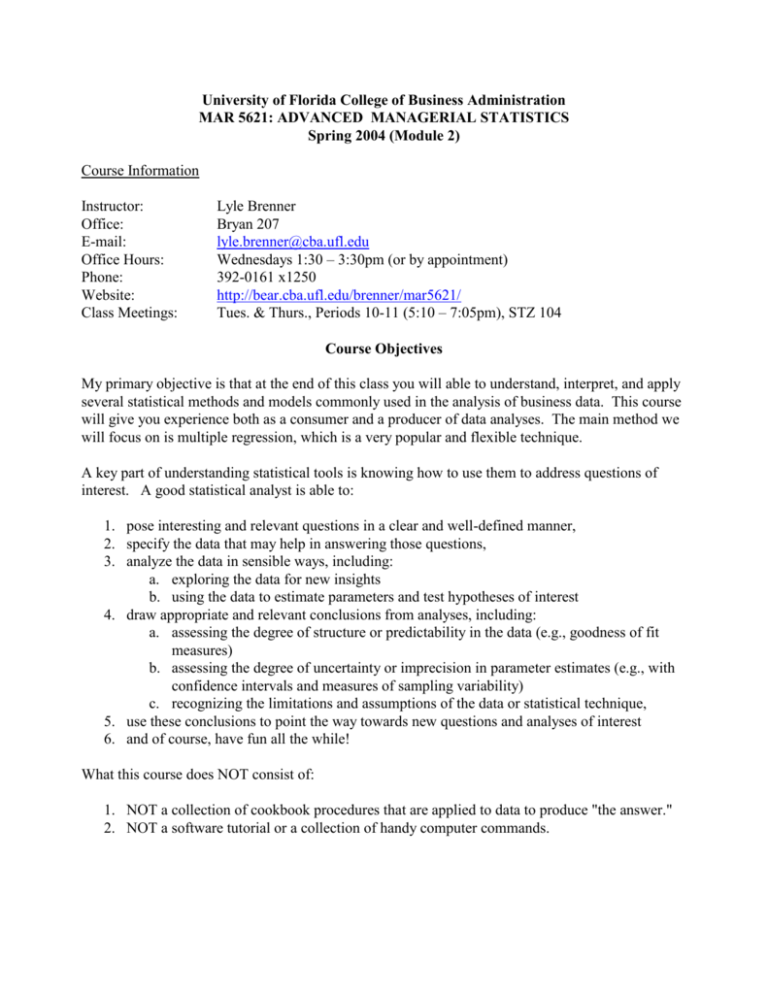
University of Florida College of Business Administration MAR 5621: ADVANCED MANAGERIAL STATISTICS Spring 2004 (Module 2) Course Information Instructor: Office: E-mail: Office Hours: Phone: Website: Class Meetings: Lyle Brenner Bryan 207 lyle.brenner@cba.ufl.edu Wednesdays 1:30 – 3:30pm (or by appointment) 392-0161 x1250 http://bear.cba.ufl.edu/brenner/mar5621/ Tues. & Thurs., Periods 10-11 (5:10 – 7:05pm), STZ 104 Course Objectives My primary objective is that at the end of this class you will able to understand, interpret, and apply several statistical methods and models commonly used in the analysis of business data. This course will give you experience both as a consumer and a producer of data analyses. The main method we will focus on is multiple regression, which is a very popular and flexible technique. A key part of understanding statistical tools is knowing how to use them to address questions of interest. A good statistical analyst is able to: 1. pose interesting and relevant questions in a clear and well-defined manner, 2. specify the data that may help in answering those questions, 3. analyze the data in sensible ways, including: a. exploring the data for new insights b. using the data to estimate parameters and test hypotheses of interest 4. draw appropriate and relevant conclusions from analyses, including: a. assessing the degree of structure or predictability in the data (e.g., goodness of fit measures) b. assessing the degree of uncertainty or imprecision in parameter estimates (e.g., with confidence intervals and measures of sampling variability) c. recognizing the limitations and assumptions of the data or statistical technique, 5. use these conclusions to point the way towards new questions and analyses of interest 6. and of course, have fun all the while! What this course does NOT consist of: 1. NOT a collection of cookbook procedures that are applied to data to produce "the answer." 2. NOT a software tutorial or a collection of handy computer commands. Course Materials Albright, Winston & Zappe, Data Analysis & Decision Making with Microsoft Excel (2nd Ed.), 2003, Duxbury. (ISBN: 053438367X.) Michael Lewis, Moneyball, 2003, Norton. (ISBN: 0-393-05765-8) Various handouts and course notes. Grading Your course grade will be based on: Assignments Quiz Final Exam 25% 25% 50% For the assignments, you may (but are not required to) work in groups of 2 people, and turn in a single submission for the team. No collaboration is allowed between different teams on assignments. (Note: All people whose names appear on an assignment will be responsible for discussing the content of the assignment in class, should they be called on.) The quiz and the final will be open-book and open-note. You may use a calculator, but no computers, phones, pagers, PDAs, etc. It is highly recommended that you create a one or two-page “summary/reference sheet” for the exams, as it will (a) help you organize the material in a way that makes sense to you, and (b) increase your speed and efficiency during the tests should you need to find something in your notes or the textbook. Academic Dishonesty While the vast majority of students are honest people, some nonetheless engage in various forms of academic dishonesty on assignments and exams. If in the judgment of the course instructor there is compelling evidence of academic dishonesty, all students involved will receive a failing grade for the course, and may be subject to additional penalties from the University. Please don’t cheat. Other comments & tips 1. Ask questions. Don’t be bashful. 2. Study to learn the material; don’t just study to score well on the tests & assignments. 3. Focus on concepts, not on formulas. Really, the math is there to illustrate the concepts, not the other way around. 4. Statistical concepts are subtle, difficult, and sometimes conflict with the ways we are used to thinking about things. It is common for many people to finally experience a “lightbulb” moment only after substantial struggling with the concepts. Try not to get frustrated if some of the concepts do not immediately make sense. 5. Also, try not to lose sight of the forest for the trees. There are a few key themes and ideas that underlie most of the material in this course. However, there are many more details, formulas, and terms to be encountered along the way. If you focus on understanding the key ideas, a lot of the seemingly unrelated details will fall into place. I will make a special effort to make sure these key ideas stand out clearly. These key ideas are both important and interesting! Tentative Course Calendar (subject to change as needed) Tues, Mar 2: Introduction to course; understanding variability and uncertainty; examples Readings: AWZ 1.3 (See Ex 11.2, 13.3) Thurs, Mar 4: Making comparisons; experiments and observational studies; determining cause and effect Tues, Mar 16: Describing bivariate data; scatterplots, covariance & correlation; the regression line Readings: AWZ 11.1 – 11.4 Thurs, Mar 18: Statistical inference for the regression line Readings: AWZ 12.2 Tues, Mar 23: Scatter around the regression line; residuals; decomposing variability with the ANOVA table Readings: AWZ 11.4.2 Thurs, Mar 25: “Regression to the mean”; applications of regression; review for quiz Assignment #1 Due Tues, Mar 30: Quiz Thurs, Apr 1: Multiple regression: Basic concepts Readings: AWZ 11.5 Tues, Apr 6: Multiple regression: Interpreting and testing regression coefficients Readings: AWZ 12.3 – 12.4, 12.7 Thurs, Apr 8: Categorical predictors and dummy variables Readings: AWZ 11.6.1 Tues, Apr 13: More on categorical predictors: Interactions between dummy and quantitative variables Readings: AWZ 11.6.2 Thurs, Apr 15: Fitting curves; transformations and polynomial regression Readings: AWZ 11.6.3 Assignment #2 Due Tues, Apr 20: Catch up, wrap up, review. Thurs, Apr 22: Final Exam

